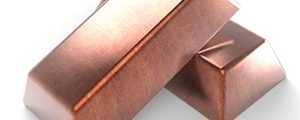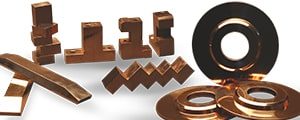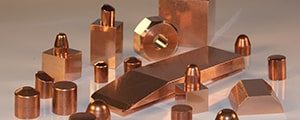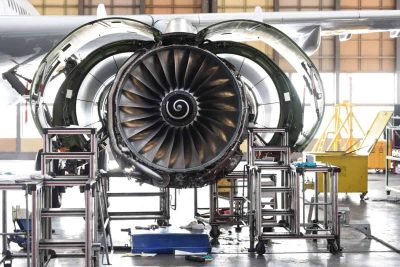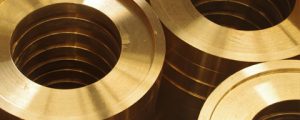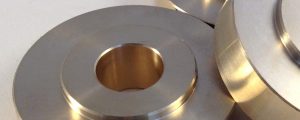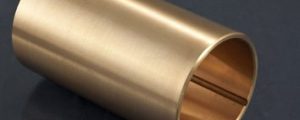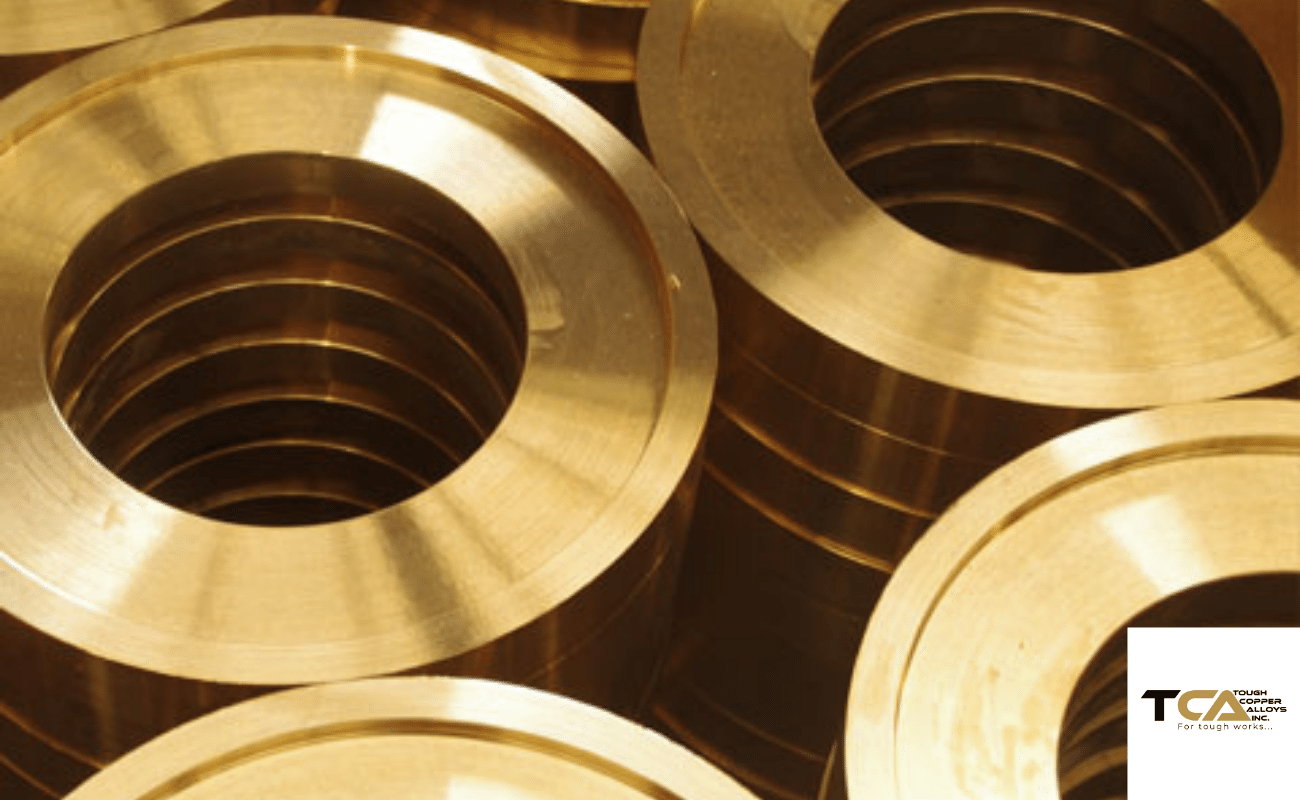What is “C61300” Material?
C61300 is a type of copper alloy that is widely used in various applications due to its excellent properties. Also known as aluminum bronze, It is a combination of copper, aluminum, iron, nickel, and manganese.
One of the main advantages of C61300 material is its high strength, which makes it ideal for heavy-duty applications. It also has good corrosion resistance, making it suitable for use in marine environments. Additionally, It has good wear resistance and is known for its excellent machinability.
C61300 is commonly used in the manufacturing of bearings, gears, valves, and other components that require high strength and good wear resistance. It is also used in the marine industry for ship propellers and other components that are exposed to saltwater.
In terms of its physical properties, C61300 has a density of 8.78 g/cm³, a melting point of 1025°C, and a thermal conductivity of 55 W/mK. It is a non-magnetic material and has a low coefficient of thermal expansion.
Overall, C61300 is a versatile material that is valued for its strength, corrosion resistance, and machinability. Its unique combination of properties makes it ideal for a wide range of applications, from heavy-duty machinery to marine equipment.
Application Areas & Industries of “C61300”
C61300, also known as aluminum bronze, is a highly versatile copper-based alloy that boasts excellent mechanical properties and corrosion resistance. To meet the demands of various industries, C61300 undergoes a range of fabrication processes that enable it to be shaped into the desired form. In this article, we’ll take a closer look at some of the most common fabrication processes of it.
Hot Working: C61300 can be easily hot worked, which means it can be forged, rolled, or extruded to produce the desired shape and properties. Hot working is a popular method for shaping C61300 into parts that require intricate designs, tight tolerances, or complex geometries.
Cold Working: It can also be cold worked to increase its strength and hardness, making it ideal for applications that require these properties. Cold working processes like cold rolling or cold drawing can also improve the surface finish of the material.
Machining: C61300 is an excellent material for machining, allowing for the production of parts with tight tolerances and complex geometries. Common machining techniques for include turning, drilling, milling, and grinding.
Welding: It can be easily welded using conventional welding techniques, such as TIG, MIG, and spot welding. Welding is a popular fabrication process for joining C61300 to other metals or for creating complex shapes and structures.
Heat Treatment: C61300 can be heat treated to improve its properties, such as strength, hardness, and wear resistance, for specific applications. The most common heat treatment process for it is annealing, which involves heating the material to a specific temperature and then cooling it slowly to improve its ductility.
In conclusion, C61300 is a highly versatile copper-based alloy that can be fabricated using a range of processes. Whether you need to hot work, cold work, machine, weld, or heat treat it, these processes can help you produce the desired shape and properties for your specific application. If you need more information about the fabrication processes of C61300 or have any other questions, please contact us today.
Chemical Composition of “C61300”
C61300 is a copper-based alloy that is also known as aluminum bronze. It has a unique chemical composition that gives it excellent mechanical properties and corrosion resistance. Here is a table that shows the chemical composition:
| Element | Percentage |
|---|---|
| Copper | 78-82% |
| Aluminum | 8-10% |
| Iron | 4-6% |
| Nickel | 4-6% |
| Manganese | 1-2% |
| Other | <1% |
As you can see from the table, C61300 contains a significant amount of copper, which is the primary component of the alloy. It also has a high percentage of aluminum, which is responsible for the material’s excellent mechanical properties, including high strength and hardness. Iron and nickel are added to the alloy to increase its corrosion resistance, while manganese is added to improve its wear resistance.
Overall, the unique chemical composition of C61300 makes it an ideal material for a range of applications, including marine equipment, pumps, valves, and bearings. If you need more information about the chemical composition of C61300 or have any other questions, please feel free to contact us.
Physical Properties of “C61300”
C61300 is a copper-based alloy that offers excellent mechanical properties and corrosion resistance. In addition to its chemical composition, the physical properties of C61300 are also essential to consider when selecting it for a specific application. Here are some of the most important physical properties:
Density: The density of C61300 is approximately 7.78 g/cm3, which is higher than that of pure copper. This high density contributes to its excellent mechanical properties, including high strength and hardness.
Melting Point: The melting point of C61300 is around 1038-1063°C (1900-1945°F). This high melting point makes it suitable for applications that involve high temperatures, such as furnace parts and welding electrodes.
Thermal Conductivity: ıt has a high thermal conductivity, which means it can transfer heat quickly and efficiently. This property makes it an excellent choice for applications that require heat dissipation, such as heat exchangers.
Electrical Conductivity: Like most copper-based alloys, C61300 has a high electrical conductivity. This property makes it an ideal material for electrical connectors, circuit breakers, and other electrical components.
Corrosion Resistance: It has excellent corrosion resistance, particularly in marine environments. Its ability to resist corrosion makes it suitable for applications that require resistance to seawater, brine, and other corrosive substances.
Overall, the physical properties of C61300 make it an excellent material for a range of applications, particularly those that require high strength, hardness, and corrosion resistance. If you need more information about the physical properties of C61300 or have any other questions, please feel free to contact us.
Fabrication Properties
C61300 is a copper-based alloy that offers excellent mechanical properties and corrosion resistance, making it a popular choice for a variety of applications. Its unique chemical composition and physical properties also make it a versatile material that can be fabricated using various techniques. Here are some of the most common fabrication properties:
Hot Working: C61300 can be readily hot worked by forging, rolling, or extruding to produce the desired shape. The material is heated to a specific temperature range and then worked using mechanical force to create the desired form.
Cold Working: It can also be cold worked to increase its strength and hardness. This process involves shaping the material at room temperature using techniques such as bending, drawing, and stamping.
Machining: C61300 can be machined using conventional methods such as drilling, milling, and turning. However, due to its high copper content, the material can be challenging to machine and requires special tools and techniques.
Welding: It can be welded using various welding techniques, including gas tungsten arc welding (GTAW) and gas metal arc welding (GMAW). However, due to the material’s high copper content, it requires careful preparation, including cleaning and preheating, to ensure successful welds.
Heat Treatment: C61300 can be heat treated to improve its properties, including strength and hardness. However, the material has limited heat-treatability, and care must be taken to avoid distortion or cracking during the process.
Overall, the fabrication properties of C61300 make it a versatile material that can be shaped and formed using various techniques. Whether you need to hot work, cold work, machine, weld, or heat treat C61300, these processes can help you produce the desired shape and properties for your specific application. If you need more information about the fabrication properties of C61300 or have any other questions, please feel free to contact us.
Applicable Specifications of “C61300”
C61300 is a copper-based alloy that offers excellent mechanical properties and corrosion resistance, making it suitable for a wide range of applications. To ensure its performance and quality, It is governed by various applicable specifications, including:
ASTM B150: This specification covers C61300 and other copper alloys in the form of plates, sheets, strips, and rolled bars. It outlines the chemical composition, mechanical properties, and other requirements for the material.
SAE J461: This specification covers various copper alloys, including C61300, in the form of bars, rods, wires, and forgings. It outlines the chemical composition, mechanical properties, and other requirements for the material.
SAE J463: This specification covers various copper alloys, including C61300, in the form of plates, sheets, strips, and bars. It outlines the chemical composition, mechanical properties, and other requirements for the material.
MIL-DTL-46027: This specification covers armor plate, aluminum alloy, weldable, 5083 and 5456, and C61300 and C46400 alloys for use against ballistic threats. It outlines the requirements for the manufacture and testing of the material.
In addition to these specifications, C61300 may also be subject to other industry-specific standards and requirements, depending on its intended use. It’s essential to ensure that the material meets the applicable specifications and standards to ensure its quality and performance.
In conclusion, C61300 is a copper-based alloy that is governed by various applicable specifications and standards, including ASTM B150, SAE J461, SAE J463, and MIL-DTL-46027. By following these specifications, manufacturers can ensure that the material meets the required chemical composition, mechanical properties, and other requirements for its intended use. If you need more information about the applicable specifications of C61300 or have any other questions, please feel free to contact us.
Thermal Properties of “C61300”
C61300 is a copper-based alloy with excellent thermal conductivity, which makes it suitable for a wide range of applications that require heat transfer. Here are some of the thermal properties:
Conductivity: C61300 has a high thermal conductivity, which means it can transfer heat quickly and efficiently. The thermal conductivity of C61300 is typically in the range of 240-260 W/mK, which is much higher than most other engineering materials.
Thermal Expansion: Like other copper alloys, C61300 has a relatively low coefficient of thermal expansion. This means that it does not expand or contract significantly when exposed to changes in temperature. The coefficient of thermal expansion for It is typically in the range of 17.3-18.5 µm/m·K.
Melting Point: It has a relatively high melting point compared to other copper alloys. The melting point of C61300 is typically in the range of 960-1065°C, depending on the specific composition of the alloy.
Specific Heat: C61300 has a relatively high specific heat capacity, which means that it can absorb a significant amount of heat without a significant increase in temperature. The specific heat of C61300 is typically in the range of 377-385 J/kg·K.
In conclusion, C61300 is a copper-based alloy with excellent thermal properties, including high thermal conductivity, low coefficient of thermal expansion, high melting point, and high specific heat capacity. These properties make it suitable for a wide range of applications that require heat transfer, such as heat exchangers, radiators, and electrical components. If you need more information about the thermal properties of C61300 or have any other questions, please feel free to contact us.
Typical Uses
C61300 is a copper-based alloy that is widely used in various industries due to its unique properties. Here are some of the typical uses of C61300:
Electrical Components: C61300 is commonly used in electrical components such as switches, connectors, and relays due to its excellent electrical conductivity and resistance to corrosion. The alloy is also used for electrical contact springs, which require good wear resistance and high conductivity.
Heat Exchangers: Due to its high thermal conductivity and excellent corrosion resistance, C61300 is used in heat exchangers, radiators, and other heat transfer applications. It is commonly used in the chemical and petrochemical industries, as well as in power generation and marine applications.
Oil and Gas Industry: It is used extensively in the oil and gas industry due to its excellent corrosion resistance and high strength. The alloy is commonly used in offshore platforms, subsea equipment, and downhole tools.
Automotive Industry: It is used in the automotive industry for a variety of applications, including engine components, transmission parts, and brake components. The alloy’s high strength, wear resistance, and thermal conductivity make it suitable for these demanding applications.
C61300 is a copper alloy with high thermal conductivity, corrosion resistance, and strength. It is used for electrical components, heat exchangers, oil and gas industry, and automotive industry. Contact us for more details.
Equivalents
C61300 is a copper-based alloy with unique properties that make it suitable for a wide range of applications. However, there are several other alloys with similar properties that can serve as equivalents to C61300 in certain applications. Here are some of the common equivalents of C61300:
CDA 954: CDA 954, also known as Aluminum Bronze, is an alloy with similar strength, corrosion resistance, and wear resistance as C61300. It is commonly used in marine applications, such as propellers and ship components, as well as in bushings and bearings.
CDA 955: CDA 955, also known as Nickel Aluminum Bronze, is an alloy that offers higher strength and better corrosion resistance than C61300. It is commonly used in marine and offshore applications, such as valve stems, pump components, and seawater piping.
CDA 958: CDA 958, also known as Leaded Nickel Bronze, is an alloy that offers excellent machinability and wear resistance, making it suitable for bushings and bearings. It has similar corrosion resistance and strength as C61300.
CDA 959: CDA 959, also known as Leaded Tin Bronze, is an alloy that offers excellent machinability and wear resistance, making it suitable for bushings and bearings. It has lower strength and corrosion resistance than C61300 but can be a cost-effective alternative in certain applications.
In conclusion, while C61300 is a unique copper-based alloy with excellent properties, there are several equivalents available that can be used in certain applications. These include CDA 954, CDA 955, CDA 958, and CDA 959, which offer similar or improved properties compared to C61300. If you have any questions about the equivalents of C61300 or need help selecting the right alloy for your application, please feel free to contact us.

